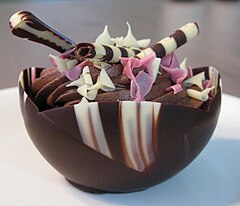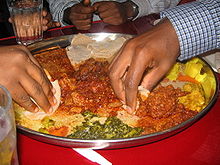Edible tableware

Edible tableware is
Overview

Edible tableware can be homemade or mass-produced, and is prepared from various foods.[2] For example, homemade tableware can be fashioned using sliced celery as chopsticks, and celery can also be used to scoop foods such as dips and cream cheese.[3] A leaf of cabbage can be used as a spoon, and a carrot stick that has been sharpened can be used as a skewer.[2] Edible bowls and plates can be prepared with many methods. Bread which has had its center removed can be used for soups, and similarly, baking cheese in an oven and forming the cheese into the desired shape.[4] Chocolate can also be fashioned into edible tableware.[a]
Flatbread such as khobez is sometimes used as an eating utensil, such as when it is used to scoop hummus, and Ethiopian injera bread is used as a utensil to scoop wat.[6] In West Africa, flatbread is sometimes used to scoop fufu for consumption.[6] In India, chapati flatbread is used as a utensil to consume sambar and dal.[7] In North and Central America, the tortilla is used as a utensil to scoop various foods such as salsa and bean dips.[8] Foods such as crackers, corn and tortilla chips, crudités, bread and cheese sticks can also be used as edible utensils.[9][10][11]
History
Edible tableware such as cups, bowls, plates and platters prepared using sugar paste have been in use since at least the Elizabethan era and edible tableware was considered as a sign of wealth.[12] In 1562, a recipe for edible tableware and cutlery, such as knives, forks, chopsticks and spoons, was published by Alexius Pedemontanus.[1]
See also
Notes
References
- ^ ISBN 978-1-59691-890-0. Retrieved June 3, 2016.
- ^ ISBN 978-1-60882-117-4. Retrieved June 3, 2016.
- ISBN 978-0-7611-7681-7. Retrieved June 3, 2016.
- ISBN 978-1-61777-168-2. Retrieved June 3, 2016.
- ^ Fresh Cup: The Voice of the Specialty Coffee Industry. Fresh Cup Publishing Company. 1997. Retrieved June 3, 2016. (subscription required)
- ^ ISBN 978-0-85786-856-5. Retrieved June 3, 2016.
- ISBN 978-1-257-11487-0. Retrieved June 3, 2016.
- ISBN 978-1-4408-0099-3. Retrieved June 3, 2016.
- ISBN 978-1-889392-54-7. Retrieved June 3, 2016.
- ^ Weiss, Laura B. (January 29, 2014). "Get Extra Points For Super Bowls Of Dips And Spreads". Minnesota Public Radio News. Retrieved June 3, 2016.
- ISBN 978-0-8118-5206-7. Retrieved June 3, 2016.
- ISBN 978-0-86243-952-1. Retrieved June 3, 2016.
